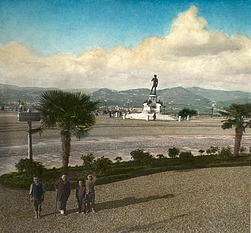Italy 1897 in color
Coloured slides by František Krátký.
František Krátký was one of the most important Czech photographers from the time of the Austro-Hungarian Empire.In addition to portrait work, he also photographed many landscapes and historical attractions. His oldest known dated historical photograph is from 1881. To give his pictures the greatest possible impact, he developed the technique of stereo-photography.
No other professional photographer of his time travelled the Czech and Moravian
countryside as thoroughly as František Krátký. Besides the Austro-Hungarian Empire, he photographed also in the Balkans, Italy, Switzerland, Russia, Germany, France and Monaco.
He also published photographs from foreign countries, taken by other photographers, for example Czech explorer, E. S. Vráz. He believed that the character of a country is expressed by its people,
and so the focus of his interest was on the people, and not just the historical places and buildings alone.
Most of the photographs in this exhibition date from his visit to Italy in April to June, 1897. The trip can be reconstructed from preserved letters he sent to his family: Florence – Rome – Naples – Livorno – Nice – Genoa – Nice – Monaco – Genoa – Turin – Milan – Verona. In June and July 1898, he took his next trip, to the Balkans. From Mostar, he travelled to Sarajevo, and then from Travnik to Zajce and on to Zagreb. He possibly made short trips to Italy in the early 1900s, and he also visited Venice, which he had bypassed on his first trip.
Hand-colored slides are a rare preserved photographic heritage, from the time before color photography became popular. They are miniature pictures, with photographic accuracy. Their base is a black and white photographic slide (usually 85 x 85 mm). Hand-colored photographs were rare even in their time, because they had to be made with great precision and attention to detail. And of course, because most of Krátký’s pictures were stereo-photographs, the intensity and shading of the coloring had to be identical on both pictures.
Texts from architecture - Eva Hubičková.































